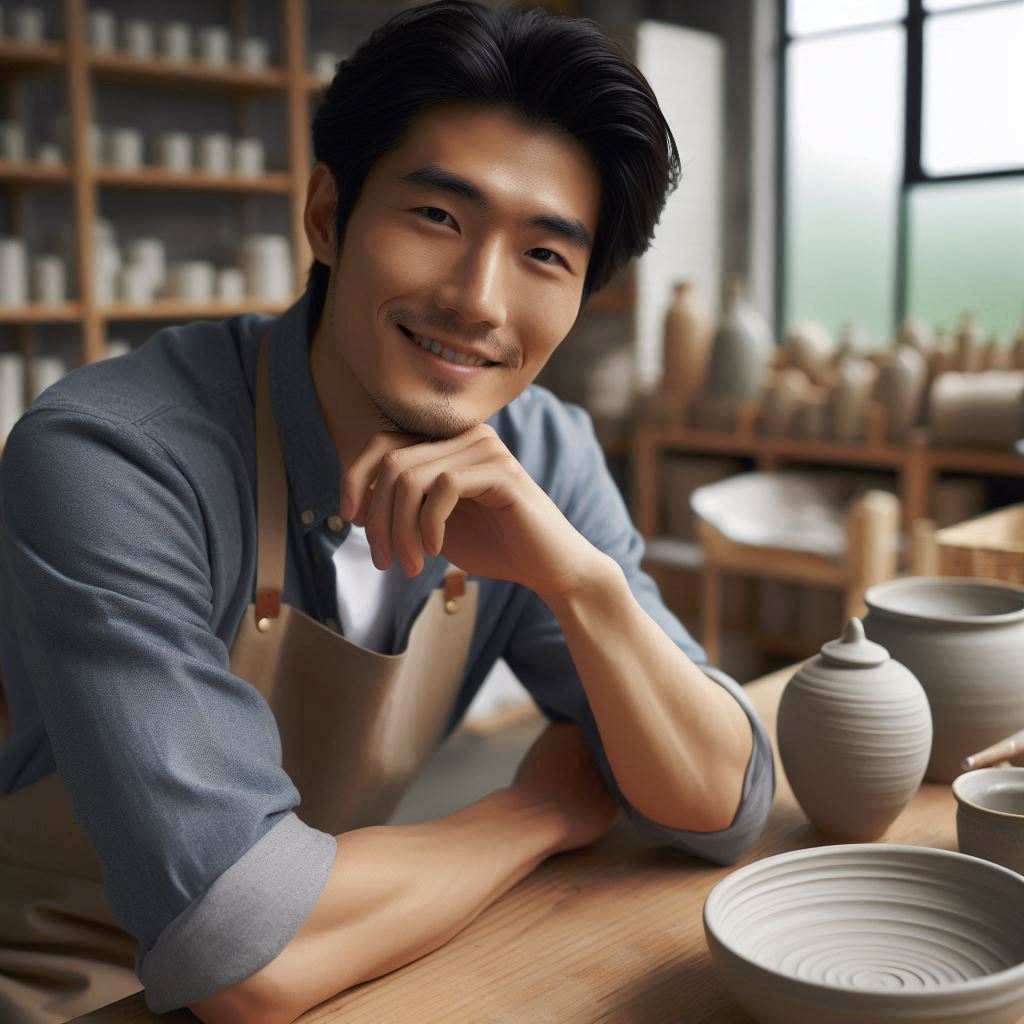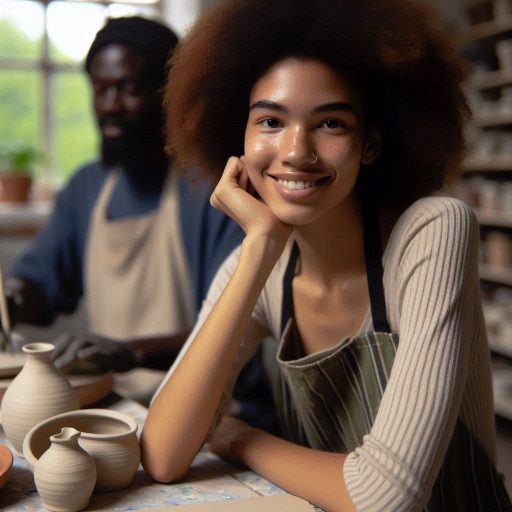Introduction
Ceramic art has a rich history spanning centuries, known for its versatility and durability.
Exploring trends and innovations in this field is crucial to keeping it vibrant and relevant.
Ceramic art encompasses various forms of art created using clay and other materials, such as porcelain and stoneware.
From functional pottery to decorative sculptures, ceramics offer endless possibilities for artistic expression.
Staying current with the latest trends and innovations in ceramic art allows artists to push boundaries, experiment with new techniques, and challenge conventional norms.
This constant evolution keeps the art form exciting and engaging for both creators and viewers.
Specific Trends and Innovations in Ceramic Art
One notable trend in ceramic art is the fusion of traditional techniques with modern technology.
Artists are incorporating digital tools, such as 3D printing and computer-aided design, to create innovative pieces that blend the old with the new.
Another trend is the exploration of sustainable practices in ceramic art.
Artists are increasingly mindful of their environmental impact, opting for eco-friendly materials and processes.
This shift towards sustainability not only benefits the planet but also challenges artists to think creatively about their craft.
Additionally, there is a growing movement towards collaborative projects in ceramic art.
Artists are coming together to share ideas, skills, and resources, resulting in dynamic and innovative artworks that showcase the collective power of teamwork.
In essence, exploring trends and innovations in ceramic art is essential for its continued growth and relevance in the contemporary art world.
By staying curious, adaptive, and open-minded, artists can push the boundaries of what is possible with this ancient medium.
History of ceramic art
Ceramic art dates back thousands of years, with early examples found in ancient civilizations such as Mesopotamia.
Throughout history, ceramic art has been used for both functional purposes, such as pottery and tools, as well as decorative art.
Ancient cultures such as the Chinese, Greeks, and Egyptians all developed unique styles and techniques in ceramic art.
Overview of the origins and evolution of ceramic art
Ceramic art can be traced back to prehistoric times when early humans created clay vessels for cooking and storage.
Over time, pottery evolved into a sophisticated art form, with artisans developing intricate designs and glazes.
Transform Your Career Today
Unlock a personalized career strategy that drives real results. Get tailored advice and a roadmap designed just for you.
Start NowThe invention of the potter’s wheel revolutionized ceramic art, allowing for greater precision and creativity in pottery making.
Traditional techniques and styles
Traditional ceramic techniques include hand-building, wheel-throwing, and glazing, each requiring skill and precision.
Styles such as Raku, majolica, and porcelain have been passed down through generations, each with its unique characteristics.
Ancient traditions like Japanese tea ceremony pottery and Greek amphora continue to influence contemporary ceramic artists.
How modern trends and innovations have been influenced by the history of ceramic art
Modern ceramic artists draw inspiration from ancient techniques and styles, incorporating them into their own innovative designs.
Advancements in technology have allowed for new methods of firing, glazing, and shaping ceramics, pushing the boundaries of traditional art.
Contemporary ceramic art reflects a blend of old and new, honoring the rich history of the craft while exploring new possibilities.
Read: Essential Supplies for Beginner Ceramic Artists
Contemporary Ceramic Artists
When exploring the world of ceramic art, it’s impossible to overlook the incredible work being done by contemporary artists.
These artists are pushing boundaries, experimenting with new ideas, and redefining what it means to work with clay.
Influential Artists in the Field
- Edmund de Waal: Known for his minimalist approach and subtle use of color, de Waal’s work challenges traditional notions of ceramics.
- Shozo Michikawa: A master of the wheel, Michikawa creates intricate and delicate forms that blur the line between functional pottery and sculpture.
- Rebecca Warren: Warren’s bold and expressive sculptures combine elements of abstraction and figuration, resulting in dynamic and energetic pieces.
- Claude Champy: Champy’s innovative use of glazes and unconventional firing techniques produce stunning and unexpected results in his work.
Their Unique Styles and Techniques
Each of these artists brings their own unique style and techniques to the world of ceramic art, creating pieces that are not only visually striking but also conceptually thought-provoking.
- Edmund de Waal: De Waal’s work is characterized by its simplicity and elegance.
He often uses a limited color palette, focusing on subtle variations in tone and texture to create pieces that are both modern and timeless. - Shozo Michikawa: Michikawa’s mastery of the wheel allows him to create forms that are at once delicate and strong.
His pieces often feature intricate surface textures that add depth and complexity to his work. - Rebecca Warren: Warren’s sculptures are a bold exploration of form and color.
She combines traditional ceramic techniques with a contemporary aesthetic, resulting in pieces that are both playful and powerful. - Claude Champy: Champy’s work is a testament to his experimental spirit.
His use of unconventional firing techniques and glazes results in pieces that are unpredictable and exciting, with each one telling its own unique story.
How These Artists Are Pushing Boundaries
By pushing boundaries and experimenting with new ideas, these contemporary ceramic artists are reshaping the field and challenging traditional notions of what ceramic art can be.
Whether it’s through innovative techniques, bold aesthetics, or a commitment to exploring new concepts, these artists are at the forefront of a movement that is redefining the boundaries of ceramic art.
As they continue to push the boundaries of the medium, these artists inspire others to explore new possibilities and find creative ways to express themselves through clay.
Read: Printmaking Techniques: Lithography Explained
Technological advancements
Technology is transforming the field of ceramic art, paving the way for new possibilities and innovations.
How technology is impacting ceramic art
Advancements in technology have opened up a world of opportunities for ceramic artists, allowing them to explore new techniques and push the boundaries of traditional methods.
Tools and equipment that are revolutionizing the field
- 3D printers: Ceramic artists can now create intricate designs with the help of 3D printing technology.
- Digital kilns: Digital kilns offer precise temperature control, resulting in more consistent and high-quality firing outcomes.
- Virtual reality: Artists are using VR technology to simulate the ceramic-making process, enabling them to experiment with different forms and textures.
Examples of how digital technology is being integrated into ceramic art creation
From designing to firing, digital technology is revolutionizing every aspect of ceramic art creation.
- Design software: Artists can now use computer-aided design (CAD) software to create intricate patterns and shapes with ease.
- Digital decals: Digital decals allow artists to transfer complex designs onto ceramics with precision and detail.
- Remote monitoring: Some kilns are equipped with sensors that allow artists to monitor the firing process remotely, ensuring optimal results.
In fact, technological advancements have significantly impacted the field of ceramic art, opening up endless possibilities for artists to experiment, innovate, and create unique and stunning pieces.
By embracing digital tools and equipment, ceramic artists are able to push the boundaries of traditional techniques and redefine what is possible in the world of ceramic art.
Transform Your Career Today
Unlock a personalized career strategy that drives real results. Get tailored advice and a roadmap designed just for you.
Start NowRead: Marketing Tips for Ceramic Artists

Sustainable practices
When it comes to ceramic art, sustainability is becoming an increasingly important focus for artists and creators.
Let’s delve into some of the key trends and innovations in sustainable ceramic practices.
Eco-friendly and sustainable methods in ceramic art
One of the main trends in ceramic art is the shift towards using eco-friendly and sustainable methods in the creation process.
Artists are exploring ways to minimize their environmental impact and create pieces that are both beautiful and environmentally conscious.
Using recycled materials and reducing waste
Many artists are now incorporating recycled materials into their ceramic work.
This not only helps reduce waste but also adds unique textures and characteristics to the finished pieces.
By repurposing materials, artists are able to create one-of-a-kind works of art that have a smaller carbon footprint.
Artists who are leading the way in promoting sustainability in their work
- Jane Doe: Known for her innovative use of recycled glass in her ceramic sculptures, Jane Doe is a trailblazer in promoting sustainability in ceramic art.
- John Smith: John Smith incorporates locally sourced clay and natural dyes in his pottery, demonstrating a dedication to eco-friendly practices.
- Amy Johnson: Amy Johnson creates stunning ceramic pieces using solar-powered kilns, showcasing her commitment to sustainable energy usage in her art.
- Sam Lee: Sam Lee experiments with upcycling techniques, turning discarded ceramic pieces into unique mosaic installations that promote reuse and reduce waste.
Read: Sustainable Practices in Printmaking
Collaborations and cross-disciplinary approaches
Collaborations in the world of ceramic art have become increasingly popular as artists seek to push boundaries and explore new possibilities.
By working with professionals from different disciplines, ceramic artists are able to bring fresh perspectives and expertise to their work.
How ceramic artists are collaborating with other creatives
Ceramic artists are partnering with designers, architects, sculptors, and even scientists to create unique pieces that blend various artistic elements.
These collaborations often result in the fusion of traditional ceramic techniques with modern design concepts.
Examples of partnerships that have resulted in innovative projects
Artist X collaborating with fashion designer Y to create ceramic jewelry pieces that reflect the latest fashion trends.
Sculptor A teaming up with a sound artist to produce interactive ceramic installations that respond to sound frequencies.
Ceramicist B working with a biologist to incorporate living organisms into ceramic sculptures, blurring the line between art and science.
How cross-disciplinary approaches are shaping the future of ceramic art
By embracing cross-disciplinary collaborations, ceramic artists are breaking away from traditional conventions and embracing a more fluid and dynamic approach to their craft.
This trend is not only expanding the possibilities of ceramic art but also challenging the boundaries of what is considered art.
Furthermore, these partnerships are enabling artists to access new markets, reach a wider audience, and stay relevant in a rapidly changing world.
As technology continues to advance, the potential for innovative collaborations in ceramic art is limitless.
Transform Your Career Today
Unlock a personalized career strategy that drives real results. Get tailored advice and a roadmap designed just for you.
Start NowCollaborations and cross-disciplinary approaches revolutionize ceramic art.
Artists push boundaries and create groundbreaking work.
These interactions drive innovation and inspire new ideas.
By working together with other creatives, ceramic artists are shaping the future of the art form and paving the way for a new era of innovation and creativity.
Find Out More: Sustainable Practices in Landscape Architecture
Social and cultural influences
Understanding the social and cultural influences on ceramic art is crucial for appreciating its diversity and significance in today’s world.
Artists often draw inspiration from societal norms and cultural movements, creating pieces that reflect their interpretation of the world around them.
How Societal Norms and Cultural Movements impact Ceramic Art
Ceramic art has always been intertwined with society and culture, reflecting the values, beliefs, and struggles of different communities.
As societal norms evolve, so does ceramic art, adapting to the changing landscape of our world.
Artists use their work as a medium to express their views on social issues such as environmental sustainability, gender equality, and racial discrimination.
Through ceramics, they can provoke thoughts, evoke emotions, and initiate conversations that challenge traditional beliefs and stereotypes.
How artists are addressing social issues through their work
Many artists are actively engaging with social issues through their ceramic art, using their creativity to shine a light on pressing matters that affect our society.
From climate change to political unrest, artists are leveraging their craft to spark change and inspire action.
One notable artist, Ai Weiwei, is renowned for his provocative ceramic installations that explore themes of human rights, freedom of expression, and political dissent.
His work serves as a powerful commentary on the state of our world and encourages viewers to question the status quo.
Examples of ceramic art that reflects cultural diversity and inclusivity
Japanese ceramics, known for their delicate aesthetics and intricate designs, reflect the rich cultural heritage and traditions of Japan.
From tea bowls to vases, Japanese ceramic art showcases the craftsmanship and artistry of its makers.
African ceramics celebrate the vibrant and diverse cultural landscape of the continent, with each piece telling a unique story of identity and belonging.
From tribal motifs to contemporary designs, African ceramic art embodies the spirit and creativity of its people.
Contemporary ceramic artists explore cultural diversity and inclusivity.
Transform Your Career Today
Unlock a personalized career strategy that drives real results. Get tailored advice and a roadmap designed just for you.
Start NowThey challenge stereotypes and embrace differences through their work.
By incorporating diverse influences and perspectives into their art, these artists are promoting a more inclusive and tolerant society.
In a nutshell, the social and cultural influences on ceramic art are vast and profound, shaping the way artists express themselves and connect with audiences.
By exploring these influences, we can gain a deeper appreciation for the diversity and richness of ceramic art in today’s world.
Conclusion
The world of ceramic art is constantly evolving, with new trends and innovations emerging regularly.
It is essential for artists and enthusiasts to stay current and open to new ideas in order to push the boundaries of this creative field.
Embracing these changes not only keeps the art form relevant but also allows for personal growth and exploration.
By being open to new techniques, materials, and concepts, artists can continue to expand their skill set and create unique and groundbreaking pieces.
For readers interested in ceramic art, I encourage you to further explore this vibrant and dynamic world in your own communities.
Attend local exhibitions, workshops, and classes to support and engage with the artists working within this medium.
By staying connected and involved, you can contribute to the growth and appreciation of ceramic art while also enriching your own artistic journey.
Remember, innovation thrives when we are curious, adaptable, and willing to try new things.
Let’s continue to celebrate and uplift the world of ceramic art together.




